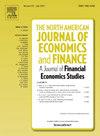高科技企业生产率对货币政策的反应
IF 3.9
3区 经济学
Q1 BUSINESS, FINANCE
North American Journal of Economics and Finance
Pub Date : 2025-08-08
DOI:10.1016/j.najef.2025.102519
引用次数: 0
摘要
本文考察了货币政策冲击对高科技企业与低技术企业全要素生产率(TFP)的影响,重点研究了借贷成本和信贷可得性的变化如何影响生产率。为了分离因果关系,我使用了来自Compustat上市公司的企业层面纵向数据,并应用了本地预测-工具变量(LP-IV)方法,其中高频利率意外作为工具变量。研究结果表明,规模较小、成立时间较短、现金持有量较低的高科技企业更容易受到紧缩货币政策冲击的影响。具体来说,两年期国债利率每上升1个百分点,高科技企业的全要素生产率就会下降约0.5%,当企业面临融资约束时,这种负面影响变得更加明显。鉴于加息对高科技企业尤其有害,我建议提供金融支持,以减轻紧缩货币政策对这些企业的不利影响。本文章由计算机程序翻译,如有差异,请以英文原文为准。
Productivity responses of high-tech firms to monetary policy
This paper examines the effect of monetary policy shocks on the Total Factor Productivity (TFP) of high-tech versus low-tech firms, focusing on how changes in borrowing costs and credit availability influence productivity. To isolate the causal effect, I use firm-level longitudinal data from Compustat’s publicly listed firms and apply the Local Projections-Instrumental Variables (LP-IV) approach, with high-frequency interest rate surprises serving as instrumental variables. The results indicate that smaller, younger, and low-cash-holding high-tech firms are more vulnerable to contractionary monetary policy shocks. Specifically, a one-percentage-point increase in the 2-year treasury rate results in approximately a 0.5 percent decline in TFP for high-tech firms, with the negative effect becoming more pronounced when firms face financing constraints. Given that interest rate hikes are particularly harmful to high-tech firms, I recommend financial support to mitigate the adverse effects of contractionary monetary policy on these firms.
求助全文
通过发布文献求助,成功后即可免费获取论文全文。
去求助
来源期刊
CiteScore
7.30
自引率
8.30%
发文量
168
期刊介绍:
The focus of the North-American Journal of Economics and Finance is on the economics of integration of goods, services, financial markets, at both regional and global levels with the role of economic policy in that process playing an important role. Both theoretical and empirical papers are welcome. Empirical and policy-related papers that rely on data and the experiences of countries outside North America are also welcome. Papers should offer concrete lessons about the ongoing process of globalization, or policy implications about how governments, domestic or international institutions, can improve the coordination of their activities. Empirical analysis should be capable of replication. Authors of accepted papers will be encouraged to supply data and computer programs.

 求助内容:
求助内容: 应助结果提醒方式:
应助结果提醒方式:


